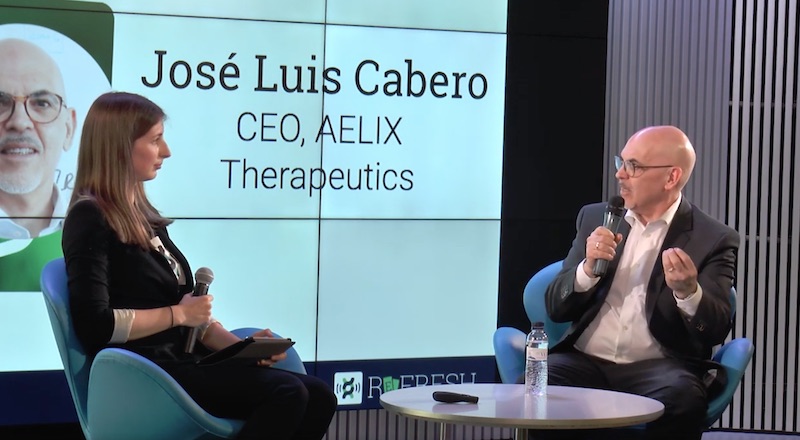Source: labiotech.eu
Vaccines are humanity’s biggest achievement against infectious diseases. But could they defeat HIV, a particularly crafty virus? José Luis Cabero, CEO of Spanish biotech AELIX Therapeutics shared his experience developing an HIV vaccine at Labiotech Refresh in Barcelona.
The concept of a vaccine is simple — priming the immune system against a pathogen so that it is prepared to fight off the real thing. This simple principle has been one of humanity’s greatest weapons against disease, with achievements including the total eradication of smallpox and severely limiting the damage caused by polio and measles.
“If you take a look at vaccines as a whole, they’re the most successful medical intervention ever,” said José Luis Cabero, CEO of AELIX Therapeutics. “There’s no medical intervention that’s been as impactful on mankind as vaccination.”
Having spent a lot of his career in companies developing vaccines, Cabero turned his sights to a new target when he joined AELIX in 2017. Founded in 2015, the company aims to develop a therapeutic vaccine for HIV, a particularly formidable foe.
Back in the 1980s, an HIV infection was essentially a death sentence. Nowadays, though, HIV-positive people can take daily antiretroviral drugs, which stop the virus from spreading.
“The world of HIV has experienced fantastic success with the development of antiretroviral treatments,” Cabero said. “[People taking these drugs] are not contagious. They have the virus under control and they can have a normal life.”
But one big limitation is that the drugs cannot cure the infection — the virus stays dormant and hidden within immune cells with the potential to rebound if the treatment stops.
In the long term, the drugs end up being the victims of their own success. “Because the treatment is successful, patients are living longer,” Cabero explained. Like everyone else, they start suffering from age-related conditions such as cardiovascular disease and osteoporosis. The problem is that antiretroviral therapy can magnify the effects of these conditions.
Making a vaccine for the infection seems like a step in the right direction for solving this issue, but there are lots of challenges to overcome.
“One of the challenges is that the HIV virus is extremely smart,” Cabero said. “The virus mutates in the replication process very rapidly. If you design a vaccine to target fragments of a virus, or a part that mutates, the vaccine will be ineffective.”
This problem has stalled the production of an HIV vaccine for decades. However, this is changing.
“We’ve seen a revival … of science around the immune response to HIV,” Cabero said. “This has been the basis of some academic groups to make a new attempt to tackle a problem we’ve had for many years that is not yet solved.”
AELIX aims to overcome these limitations by learning from the immune system of people that are innately better at keeping the HIV virus at bay, who are called ‘HIV controllers’. The company analyzed samples from around 1,000 HIV-positive people and found that the immune systems of the controllers target specific regions of the HIV virus that non-controllers’ miss.
Equipped with this knowledge, AELIX has designed an HIV vaccine to convert all patients into controllers, removing the need for daily antiretroviral medication. “We administer the vaccine a number of times, and the aim is to take away the antiretroviral treatment,” Cabero said.
AELIX is currently testing its vaccine in a phase I trial in individuals with early-stage HIV infection, with results expected late 2020. Last year, the company entered a partnership to test its vaccine in combination with Gilead’s drug vesatolimod, which activates HIV viruses hiding in immune cells to make them vulnerable to immunotherapy. Results from the trial are expected by 2021.
AELIX has plenty of competition in designing an HIV vaccine, including a vaccine from the University of Oxford that allowed 5 out of 15 patients to stop antiretroviral therapy for weeks. However, according to Cabero, other teams design vaccines based on target regions using computer predictions, without much practical proof that the regions produce an effective vaccine.
“The major difference of AELIX is that our immunogen is based on real data,” Cabero said. “The inventors have looked at the cells of the infected patients, analyzed which part of the virus is recognized by those cells, and derive the construction of the vaccine in this way. All other vaccines that have been tried are theoretical, in silico.”
Aside from vaccines, there are many different approaches in development to reduce our dependence on antiretroviral therapies. For example, the company TC Biopharm is developing genetically engineered T cell (CAR-T) therapies that could tackle the HIV virus. The company Abivax is developing a drug that can attack the HIV hidden within immune cells, providing a functional cure for the condition.
An alternative approach is using the gene editing tool CRISPR/Cas9, which has entered a storm of controversy after the tool was reportedly used to gene edit babies to express an HIV-resistance mutation, potentially putting their health at risk.
While there are many modern methods for fighting HIV, the field of vaccines is one of the few that has stood the test of time with many other infectious diseases. It’s likely that, whoever crosses the finish line first, vaccines are going to play an important role in HIV treatments to come.
